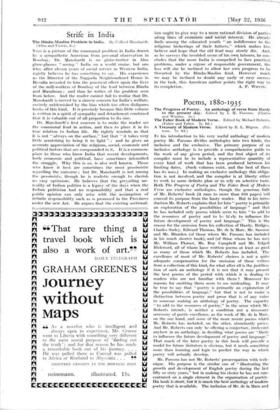Strife - in India
Tuts is .a picture of. the communal problerhin India drawn by a sympathetic. American from personal observation in Bombay. Dr. Manshardt is no globe-trotter in blue glare-glasses " seeing "- India on a world cruise, but one who, after eleven years of social service in Western India, rightly believes he has something to say. His experience as the Director of the Nagpada Neighbourhood House in Byculla revealed to him the practical effect upon the lives of the. mill-workers of Bombay of the feud between Hindu and Musulinan ;. _ and thus he writes of the problem seen from below. And the reader cannot fail to realise that Dr. Manshardt is moved by a sincere concern for India's welfare, entirely unblemished by the bias which too often disfigures books of this kind.. It is precisely because this little volume is written in a spirit of sympathy and detachment combined that it is valnable nut of all proportion to .its. size.
Dr. Manshardt's first concern is to make. the reader see the communal feud -in action, and then to place it in its true relation to Indian life. He rightly reminds us that it is not " always on the surface,". but that " it takes very little scratching to bring it to light ".; and he gives an aceurate_appreciation of thereligioits, social, economic and political factors that are compounded in it. It is a common- place to _those who know India thati.recent cievelopments, both economic and political,, have sometimes intensified the struggle. Why_ this is so, is also well known. Those who know it .best are sqmetinies the most . pessimistic
regarding the outcome ; but Manshardt is not among the pessimists, though he is realistic enough to cherish no easy optimism. Hie bejieves :that The, prevailing un- reality of Indian politics is a legacy .of the dad' when the Indian pOlitician had no responailiflity and that a real public opinion can only arise With the assumption of definite responsibility such as is promised in the Provinces under the new Act. He argues that the existing sectional- ism ought to give way to a more rational division of parties along lines;Of eenii6iiiic arid' Waif-interest. 'He -already finds among the educated youth " an indifference to the religious bickerings of their fathers," which makes him believe and hope that the old feud may slowly die. And, as lie surveys the troubled scene of his own labours, he con- cludes that the more India 'is compelled to face practical problems, under a regime of responsible government, the less will she be inclined to allow her own progress to: :be thwarted by the Hindu-Muslim feud. However much we may be inclined to doubt any early or easy success in the task, this American author points the right way to


















































 Previous page
Previous page